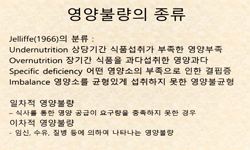Picky eating is frequently observed in early childhood and relate to feeding difficulty, eating small amounts, food neophobia, and strong preference for food types or cooking methods. This eating problems can lead to improper nutritional and growth st...
http://chineseinput.net/에서 pinyin(병음)방식으로 중국어를 변환할 수 있습니다.
변환된 중국어를 복사하여 사용하시면 됩니다.
- 中文 을 입력하시려면 zhongwen을 입력하시고 space를누르시면됩니다.
- 北京 을 입력하시려면 beijing을 입력하시고 space를 누르시면 됩니다.
Association of picky eating habits with dietary intake and growth status in early childhood = 유아의 까다로운 식습관의 다면적인 특성과 영양 상태의 연관성
한글로보기부가정보
다국어 초록 (Multilingual Abstract)
So, this study was performed to evaluate the picky eating habits of toddlers and preschool children using a multi-faceted approach and to examine the association between picky eating behaviors and dietary intake and growth status.
A cross-sectional study was conducted on the caregivers of children aged between 1 and 5 years in the Seoul Metropolitan area between September 2014 and July 2015. The survey included a self-administered questionnaire about food behavior of children and sociodemographic information and care environment, anthropometrics, and non-consecutive 3 days food records. This study included the data of 184 children from the self-reported data of 221 children’s caregivers; 37 children were excluded because of incomplete dietary data and problems affecting food intake.
Perception of caregivers was assessed involving feeding difficulty and pickiness of child. Four constructs of children’s picky eating behaviors included eating small amounts, neophobic behavior, refusal of specific food groups, and preference for a specific food preparation method. Differences in the nutrient intake and growth status between picky eaters and non-picky eaters were tested by ANCOVA test, after adjusting for sociodemographic characteristics.
The highest proportion of picky eaters was preference for a specific food preparation method. Picky eating behavior occurred more frequently than perception of caregivers. Perception of caregivers about feeding difficulty and pickiness was relate to lower intake of energy and some micronutrients and poor growth, especially in children aged 4 to 5 years. Children ‘eating small amounts’ consumed less energy and most micronutrients, except calcium, but other picky behaviors resulted in a significant difference regarding nutrient density for some micronutrients. ‘Eating small amounts’ was related to lower growth status; whereas the other picky behaviors did not show any significant difference in growth status. Specific picky behaviors were related to perception of caregivers; especially eating small amounts was strongly related to the perception of caregivers.
This study identified that picky eating problems occurred in Korea, similar with other countries and specific picky eating behaviors, especially ‘eating small amounts’, were related to the insufficient nutrient intake and lower growth status in early childhood and can lead to feeding problems to caregivers. Thus, intervention to improve the eating behaviors of children and education regarding favorable feeding practices for caregivers are required to help children establish healthy eating habits.
Picky eating is frequently observed in early childhood and relate to feeding difficulty, eating small amounts, food neophobia, and strong preference for food types or cooking methods. This eating problems can lead to improper nutritional and growth status in children which can continue to adolescence and adulthood. However it has not been well defined and generally measured by perception of caregivers. Also, the association between picky eating behaviors and nutritional status has not been investigated in depth.
So, this study was performed to evaluate the picky eating habits of toddlers and preschool children using a multi-faceted approach and to examine the association between picky eating behaviors and dietary intake and growth status.
A cross-sectional study was conducted on the caregivers of children aged between 1 and 5 years in the Seoul Metropolitan area between September 2014 and July 2015. The survey included a self-administered questionnaire about food behavior of children and sociodemographic information and care environment, anthropometrics, and non-consecutive 3 days food records. This study included the data of 184 children from the self-reported data of 221 children’s caregivers; 37 children were excluded because of incomplete dietary data and problems affecting food intake.
Perception of caregivers was assessed involving feeding difficulty and pickiness of child. Four constructs of children’s picky eating behaviors included eating small amounts, neophobic behavior, refusal of specific food groups, and preference for a specific food preparation method. Differences in the nutrient intake and growth status between picky eaters and non-picky eaters were tested by ANCOVA test, after adjusting for sociodemographic characteristics.
The highest proportion of picky eaters was preference for a specific food preparation method. Picky eating behavior occurred more frequently than perception of caregivers. Perception of caregivers about feeding difficulty and pickiness was relate to lower intake of energy and some micronutrients and poor growth, especially in children aged 4 to 5 years. Children ‘eating small amounts’ consumed less energy and most micronutrients, except calcium, but other picky behaviors resulted in a significant difference regarding nutrient density for some micronutrients. ‘Eating small amounts’ was related to lower growth status; whereas the other picky behaviors did not show any significant difference in growth status. Specific picky behaviors were related to perception of caregivers; especially eating small amounts was strongly related to the perception of caregivers.
This study identified that picky eating problems occurred in Korea, similar with other countries and specific picky eating behaviors, especially ‘eating small amounts’, were related to the insufficient nutrient intake and lower growth status in early childhood and can lead to feeding problems to caregivers. Thus, intervention to improve the eating behaviors of children and education regarding favorable feeding practices for caregivers are required to help children establish healthy eating habits.
목차 (Table of Contents)
- I. INTRODUCTION 1
- 1. Background 1
- 2. Purpose of the study 3
- II. LITERATURE REVIEW 4
- I. INTRODUCTION 1
- 1. Background 1
- 2. Purpose of the study 3
- II. LITERATURE REVIEW 4
- 1. Definition and measurement of picky eating 4
- 2. The influence of picky eating habits on dietary intake in early childhood. 7
- 3. The influence of picky eating habits on growth status in early childhood. 9
- III. METHODS 11
- 1. Study subjects 11
- 2. Measurements 15
- A. Socio-demographic information and childcare environment 15
- B. Picky eating habits 16
- C. Dietary intakes 18
- D. Growth status 19
- 3. Statistical analysis 20
- IV. RESULTS 21
- 1. Distribution of picky eaters among the study subjects 21
- 2. Sociodemographic characteristics of picky eaters 27
- 3. Dietary intake of picky eaters 31
- 4. Growth status of picky eaters 35
- 5. Association between caregivers perception and childs picky eating behaviors 38
- V. DISCUSSION 41
- VI. SUMMARY AND CONCLUSION 49
- VII. REFERENCES 52
- Korean abstract 59
- Appendix 62










